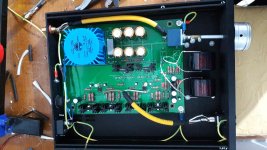Here's what I measured
Pin1 12k
Pin2 2M
Pin3 100k
Pin4 1k
Pin5 100K
pin6 25M
Pin7 16K
Pin8 15K
Pin1 12k
Pin2 2M
Pin3 100k
Pin4 1k
Pin5 100K
pin6 25M
Pin7 16K
Pin8 15K
Looking and looking at the diagram, ideas came to me, if I wanted to eliminate the input stage and change it with a tube buffer? Do I need a non-unitary gain to enter the fets?
You need the opamp in the feedback loop to keep the DC offset controlled, or something else in the circuit to address it.
You need the opamp in the feedback loop to keep the DC offset controlled, or something else in the circuit to address it.
I understand, so you should design an input stage from the beginning
Curious what it was?😀
In a pin of the c7 there was no contact between the tracks in the two sides of the pcb, being a double layer probably the pond had not passed into the hole, then using a shielded cable and connecting all sides of the enclosure to ground I solved all the buzzing problems 😎
Looking at the finished assembly, it looks like it could have been designed to be mounted with the board rotated anticlockwise by 90* - the volume pot could have an extension shaft and be mounted off-board except the o/p transistor heatsink is in the way - maybe lay this down or cut a groove thru it - maybe on the next version?
It's surprising to see the long tracks between the input IC and the Left (on the photo) output stage, but it obviously doesn't affect the amp's operation or stability ...
What are the vertical axial caps next to the opto ICs?
It's surprising to see the long tracks between the input IC and the Left (on the photo) output stage, but it obviously doesn't affect the amp's operation or stability ...
What are the vertical axial caps next to the opto ICs?
Thanks for looking. Axial Cap is vishayLooking at the finished assembly, it looks like it could have been designed to be mounted with the board rotated anticlockwise by 90* - the volume pot could have an extension shaft and be mounted off-board except the o/p transistor heatsink is in the way - maybe lay this down or cut a groove thru it - maybe on the next version?
It's surprising to see the long tracks between the input IC and the Left (on the photo) output stage, but it obviously doesn't affect the amp's operation or stability ...
What are the vertical axial caps next to the opto ICs?
Very nice. So boards will be available in the store at some point?
Yes. Working on that now.
I am very excited to get started. Thanks for all the hard work.

Another one.
Finished today (I've spent almost the whole day in a cold conservatory in order not to have have to clean my electronics mess in the kitchen for the meals).
Op amp ne5532 for now. I have lm4562 ready for this one (never listened to it in anything). I've ran out of loose Opa2134, but I will take one from c'moy as well.
First tried with some test phones (they survived), then with Senn PX100 (also survived), now listening through Senn HD595 ;-)
First impression: very nice amp! Very quiet. Somehow I never managed to get rid of some hum in my Marcello's Zen HPA (all deficiencies are my fault, not designer's).
Thanks to Wayne!!!
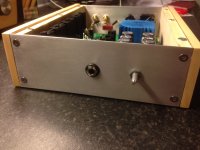
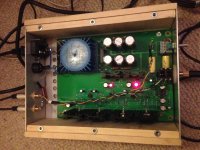
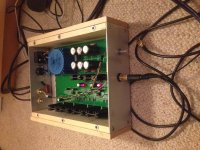
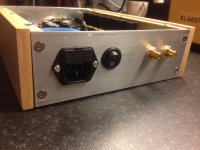
Finished today (I've spent almost the whole day in a cold conservatory in order not to have have to clean my electronics mess in the kitchen for the meals).
Op amp ne5532 for now. I have lm4562 ready for this one (never listened to it in anything). I've ran out of loose Opa2134, but I will take one from c'moy as well.
First tried with some test phones (they survived), then with Senn PX100 (also survived), now listening through Senn HD595 ;-)
First impression: very nice amp! Very quiet. Somehow I never managed to get rid of some hum in my Marcello's Zen HPA (all deficiencies are my fault, not designer's).
Thanks to Wayne!!!




Ne5532 has not stayed in the amp for a long. Tried Lm4562 for a few days. I really liked the sound. Today switched to Opa2134. Probably less air. I need to give it a few days again. Meanwhile I resurrected the Zen HPA, added some R's between the C's in the psu. Amazing what some simple stuff can do. Still some residual hum, but almost benign. I can't decide which amps better.
Next time you order from Farnell, Mouser, etc..., get an ONsemi LM833. I think you'll be pleasantly surprised for less than $1
I definitely will try more opamps. As for single ones: there is not much space near the opamp socket between two caps. Do you need a special adapter which holds them vertically?
The final question: I have -17mV offset on both channels. Regardless of the opamp. My supply is not exactly symmetric but I guess you cannot expect perfect symmetry with 7915/7815, can you? I 've read EUVL explanation of the photocoupler's role. I see how it stabilizes current but can't see how it can affect dc offset. I am not very worried about the offset now, I need to understand more before I start changing resistors on the transistor side of the coupler.
The final question: I have -17mV offset on both channels. Regardless of the opamp. My supply is not exactly symmetric but I guess you cannot expect perfect symmetry with 7915/7815, can you? I 've read EUVL explanation of the photocoupler's role. I see how it stabilizes current but can't see how it can affect dc offset. I am not very worried about the offset now, I need to understand more before I start changing resistors on the transistor side of the coupler.
- Home
- Amplifiers
- Pass Labs
- New PassDIY Headphone Amp (now available)

